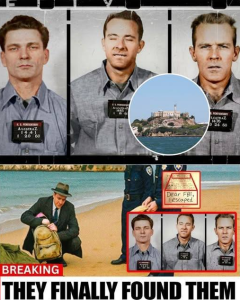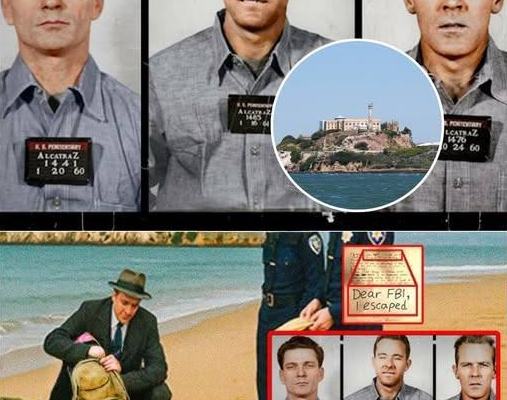
The Untold Truth Behind the Alcatraz Escape
Few prison break stories have fascinated the world quite like the escape from Alcatraz in June 1962. Known as “The Rock,” Alcatraz Federal Penitentiary was designed to be inescapable, a fortress of steel and concrete isolated on an island in the middle of San Francisco Bay. Housing some of the most notorious criminals of its time, including Al Capone and “Machine Gun” Kelly, it carried a reputation as the toughest prison in America. Yet, three men—Frank Morris and brothers Clarence and John Anglin—managed to disappear from its walls in an escape so daring that it continues to puzzle investigators, historians, and the public more than 60 years later.
While the official story long maintained that the men drowned in the treacherous waters, compelling evidence has emerged suggesting otherwise. The “untold truth” lies in the details: how carefully the escape was planned, what evidence points to survival, and why the mystery endures.
Life on “The Rock”
Opened as a federal prison in 1934, Alcatraz was built to contain inmates considered too dangerous or prone to escape from other prisons. It was notorious for its strict rules, harsh conditions, and the psychological toll of isolation. The prison was surrounded by icy waters with powerful currents, making the idea of swimming to freedom seem like a death sentence.
For inmates, the thought of escape was both a fantasy and a form of resistance. Few had the courage to attempt it, and even fewer succeeded. By 1962, the prison had already seen 14 escape attempts involving 36 men; most were captured, some were shot, and a handful were presumed drowned. None, however, captured the public imagination like the attempt led by Morris and the Anglin brothers.
The Architects of Escape
Frank Morris was no ordinary criminal. Born into poverty, he was highly intelligent, scoring in the top 2 percent on IQ tests. His background in burglary and prior escape attempts made him both resourceful and daring. When transferred to Alcatraz in 1960, he quickly assessed its weaknesses.
The Anglin brothers, Clarence and John, grew up in Georgia and later Florida as part of a large farming family. Skilled swimmers and construction workers, they shared a close bond. Arrested for bank robbery, they were also sent to Alcatraz after multiple escape attempts from other prisons.
The men met on “The Rock,” and together they formed a secret alliance. Over time, they began planning what would become the most famous escape in U.S. prison history.
The Ingenious Plan
The escape required patience, creativity, and extraordinary attention to detail. Using makeshift tools such as spoons stolen from the dining hall, the men chipped away at the concrete walls around the ventilation grates in their cells. They disguised the noise with music during permitted playing of an accordion and used painted cardboard to conceal the holes.
The ingenuity didn’t stop there. They constructed life vests and a raft out of 50 stolen raincoats, carefully stitched and sealed using prison workshop materials. To create the illusion they were asleep in their beds, they molded papier-mâché dummy heads, painting them with flesh-colored paint and using real human hair obtained from the prison barbershop.
Their plan was a masterclass in deception and resourcefulness. On the night of June 11, 1962, the men squeezed through the holes in their cells, climbed to the roof via a utility corridor, and launched their makeshift raft from the shoreline. By the next morning, they were gone.
The Official Account: Presumed Dead
The FBI launched a massive manhunt. Authorities scoured the bay and nearby communities, convinced that no one could survive the frigid waters and strong currents. Days later, pieces of the raft and a paddle washed ashore. This discovery, combined with the lack of confirmed sightings, led investigators to declare the escapees dead. The case was officially closed in 1979, with the Bureau insisting the men had drowned.
Yet, the absence of bodies left the door open to speculation. Could three determined men, equipped with makeshift flotation devices, have beaten the odds? Many experts and amateur sleuths argue the answer is yes.
Evidence Suggesting Survival
Over the decades, intriguing clues have surfaced:
-
Letters and Photographs
In 2013, a letter allegedly written by John Anglin was delivered to San Francisco police, claiming he had lived in hiding and was ready to negotiate medical care in exchange for leniency. While its authenticity remains unverified, handwriting analysis suggested it could plausibly have come from him.Family members of the Anglins also presented photographs that appear to show the brothers alive in Brazil in the 1970s. Though debated, forensic experts found the images credible enough to keep the mystery alive.
-
Family Testimonies
The Anglin family has long insisted the brothers survived. Their mother reportedly received flowers each Mother’s Day for years, allegedly sent anonymously by her sons. At her funeral in 1973, two tall, mysterious men were spotted in attendance—believed by some to be Clarence and John. -
Oceanographic Studies
In 2014, researchers at Delft University in the Netherlands used computer models to simulate the tides and currents of San Francisco Bay on the night of the escape. Their findings suggested that if the men left the island between 11:00 p.m. and midnight, the currents could have carried them safely toward Angel Island rather than out to sea.
Why Authorities Denied Survival
If the men did survive, why maintain the official story of their deaths? Part of the answer lies in the reputation of Alcatraz. The prison was built to be escape-proof. Admitting that men had beaten the system would undermine the credibility of the entire federal prison system. At the time, during the height of the Cold War, projecting strength and control was paramount.
Moreover, by declaring the men dead, law enforcement could close the case without committing endless resources to a potentially unresolvable manhunt.
Cultural Legacy
The escape from Alcatraz became legendary, inspiring books, documentaries, and films—most notably the 1979 Clint Eastwood movie Escape from Alcatraz. The story symbolizes defiance against impossible odds, blending ingenuity, courage, and mystery.
Tourists visiting Alcatraz today often linger at the cells of Morris and the Anglin brothers, staring at the dummy heads that remain on display. For many, it’s less about whether they survived and more about the idea that they dared to challenge the impossible.
The Enduring Mystery
Six decades later, the fate of Morris and the Anglin brothers remains one of America’s greatest unsolved mysteries. Did they perish in the bay, swallowed by icy waters? Or did they slip quietly into new lives, perhaps in South America, watching from afar as their daring feat turned into legend?
While the FBI may have closed the case, curiosity hasn’t. Amateur investigators, journalists, and even family members continue to search for definitive answers. Each new photograph, rumor, or forensic analysis reignites the debate.
Conclusion
The untold truth behind the Alcatraz escape lies not just in the details of the plan or the evidence of survival, but in what the story represents. It challenges our notions of security, human determination, and the boundaries of possibility. Whether Morris and the Anglin brothers lie at the bottom of San Francisco Bay or lived out their days in secrecy, their legacy is secure: they transformed an island fortress into the stage for one of history’s greatest mysteries.
In the end, Alcatraz may have been designed to keep men in, but the 1962 escape ensured their story would live forever outside its walls.

